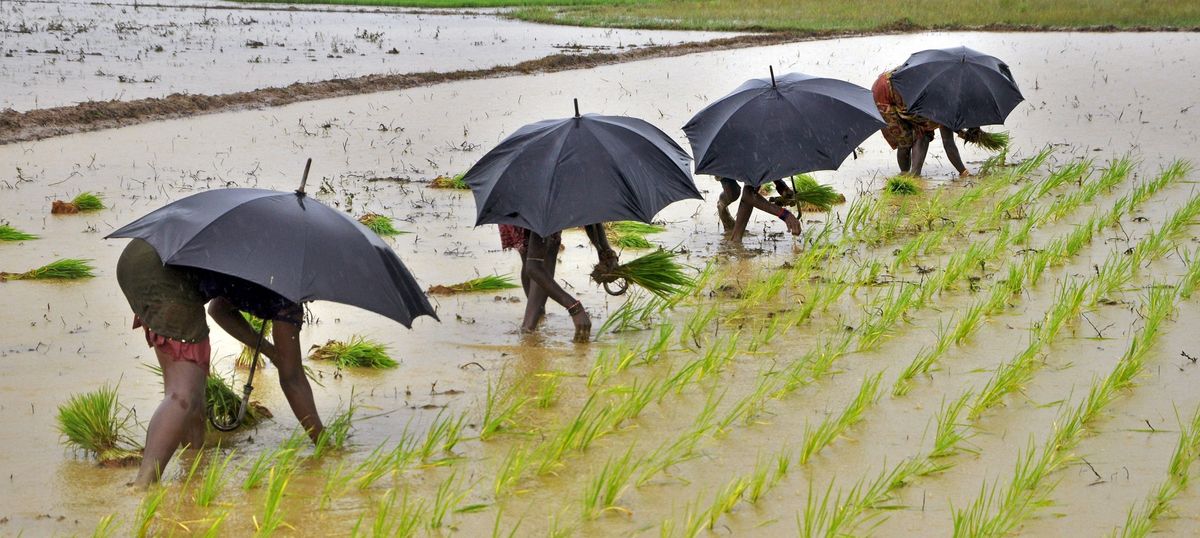What is needed is transparency on food and weather data, and stricter control on agri-processors and food warehouses, so that India doesn’t get trapped in a food speculation trap again.
November brings doubts about the fate of India’s food security. Compare kharif production estimates for 2023-2024 with the deficit monsoon report for kharif, and match them with hyperinflation in food, price volatility and erratic rains, and something does smell fishy.
Once we read them together, one of them don’t seem to make sense, because India is largely a rain-fed agrarian system and a bad monsoon with extreme erratic rain events has a very high probability of dampening agricultural production, yet the crop estimates that paddy production dipped only 3.79% despite increased area under paddy cultivation. So the figures seem to be leading the reader astray.

But before diving into crop production, let us look at the monsoon. India is under the El Niño spell, which correctly points to irregular monsoon and probable drought-like situations. It was no surprise that August was almost drought-like, as cyclone Biparjoy showered excessive rainfall on western India, right before our traditional monsoon began. Then came a drought-like August, reporting the lowest rainfall in decades. September brought a little relief, but October again exacerbated the problems of farmers, especially in rain-fed areas. From Telangana to Kerala, the south experienced heavy rainfall deficits. Kerala had a deficit of 34%.
Along with the drought-like months, 2023 also witnessed 2,321 heavy rainfall events, with precipitation of 11.5-20.5 cm in 24 hours. The devastation caused by these events brought farming and even life to a standstill in many parts of the country. Areas of Himachal and Punjab are still reeling from flood and rain damage.
Apart from these, there were also 421 extremely heavy rain events, with precipitation over 20.5 cm in 24 hours, in 2023. Now, the IMD and the government are consulting their rain gauges and trying to say that it was a near-normal monsoon, but this is very far from the truth. The monthly average of rain could hide important agrarian gaps and can’t be trusted, especially for understanding agriculture.
All over India, farmers reported floods and drought-like conditions, especially when it was time to irrigate the kharif crops. After an early sowing due to government advisories and cyclone Biporjoy, kharif fields were left dry in August, putting a biotic stress on the crops. Farmers without irrigation suffered during this period.
In most agrarian clusters, erratic rains broke routine crop-growing cycles and untimely excessive moisture when it rained promoted the emergence of new pests and plant diseases, which farmers did not anticipate. The crisis in the supply of tomatoes and vegetables in early July-August bore testimony to this disruption. Rabi sowing is also being impacted as the retreating monsoon failed to get water to rain-fed areas. This problem is only increasing and we may be looking at a reprise of 2019, which featured extreme rainfall damage.
Now, let’s talk about food production. Keep in mind that kharif production and rain are deeply connected. Alarm bells started to go off in September, when the US Department of Agriculture predicted that Indian rice production would fall by 3% this kharif. Experts and the government brushed it off but recently, the government released kharif crop estimates and admitted that paddy production has fallen by 3.76% despite an increase in acreage. The government also stated that the “total kharif pulses production for 2023-24 is estimated to be lower than previous year due to climatic conditions. Total kharif pulses production during 2023-24 is estimated at 71.18.”
So, apart from rice, lentils are also squeezed. When we look at other food crops or cattle fodder, kharif has under-performed. Repeated spells of hyperinflation in vegetables doesn’t point to a regular kharif production cycle, either. The monsoon report also signals that, yet the crop production figures don’t correspond to the monsoon damages. If all the other signs are true, the crop production should be much lower than expected.
The question is, which one is more correct. If the monsoon data is correct, crop losses should be higher, and if the crop estimates are correct monsoon figures should have been much better.
The government wants to reduce public panic or another spell of food inflation and hoarding, and remains ambiguous on the real food situation while silently moving to implement stricter controls through import restrictions, close monitoring of food stocks and price controls, etc to check a food crisis before elections.
The recently released Global Hunger Index 2023 puts India at the 111th spot among 125 countries. For a couple of years, it has pointed to a steady deterioration of food security in India. Now with a bad kharif and uncertain rabi, Indians need to brace for more food troubles ahead. What is needed is transparency on food and weather data and stricter control on agri-processors and food warehouses, so that India doesn’t get trapped in a food speculation trap again.
visit – https://shorturl.at/csES2





